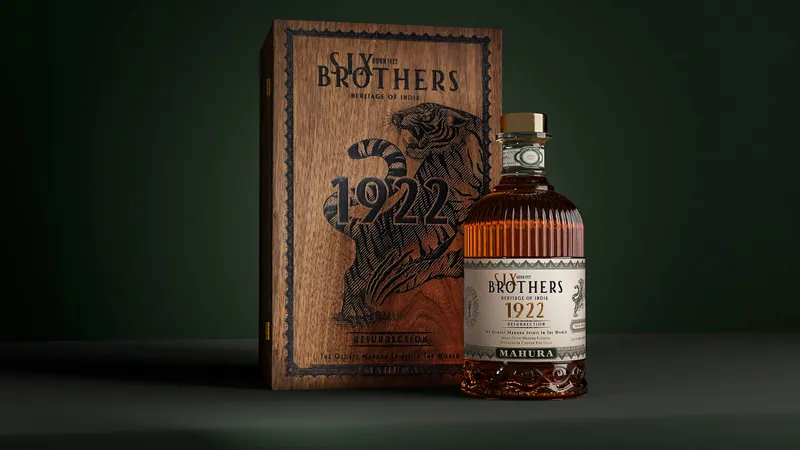Artisanal, zero ABV, tequila cocktails: What Indian drinkers will cheer to in 2025
From AI-powered bartending to heritage spirits making a comeback, YS Life dives deep to understand the trends that will shape the alco-bev industry in 2025.
In 2024, the Indian alco-bev industry raised the bar. While Bengaluru’s only speakeasy bar ZLB23 made it to Asia’s 50BestBars list, 21 new bars made it to the 30BestBarsIndia list.
The list saw the return of small-format bars that offer personalised and experiential drinking experiences, focusing on craft cocktails, exclusive pairings, and elevated storytelling. The consumer today wants bespoke and intimate experiences where drinks don’t just accompany the great food, but take centre stage.
“Consumers are shifting towards drinking for the experience, rather than just drinking to get drunk,” Avinash Kapoli, Co-founder of F&B consultancy company Kompany Hospitality, and Co-founder of bars SOKA, Jamming Goat, and Jamming Goat 3.0, tells YS Life.
In 2025, bars will focus more strongly on their design aspects—the menu, the ambience, the upholstery, and the story, believes Vikram Achanta, Founder and CEO of Tulleeho (beverage education, training and consulting firm) and Co-founder of 30BestBarsIndia.There will be more focus on cocktail programmes with small bites menus. The bar styles, Achanta emphasises, will be influenced by the Japanese omakase-style, or be largely thematic or spirit-focused.
YS Life speaks to industry stakeholders and rule-makers on the broader trends that will shape India’s growing alco-bev industry.
Cocktails: Artisanal, hyperlocal and sustainable
Globally, top bar calls were for mojitos, margaritas, spritzs, pina coladas, and G&T (gin and tonic), states the Bacardi Cocktail Trends Report 2025. In India, the usual classics—cosmopolitan, whiskey sour, mojito, negroni and agave-based margarita remained the most popular orders across India’s top 116 bars (What India Is Drinking- Annual Brand Survey 2024, by 30BestBars India).
However, in 2025, the narrative is expected to change. Think small-batch cocktails with craft spirits, with artisanal and regional flavours. “The wheel has slowly been turning towards artisanal without frills,” says Kiran Kumar HV, Director at Bengaluru-based bar Gawky Goose.

Luck by martini: How Shatbhi Basu broke the glass ceiling in India’s bar industry
Prathik Shetty, Co-founder of Bengaluru-based cocktail bar The Reservoire, notes that drinkers are well-travelled and well-aware and want to be served an experience. “Clarified drinks, despite their intricate preparation process involving syrups and ingredients that take days to perfect, have become a favourite due to their simplicity and versatility,” he adds.
India’s cocktail consumers have now moved away from bottled, syrupy, sugar-loaded mixers. The focus, in 2025, will shift towards hyperlocal, fresh, and readily available ingredients, reducing dependency on imported bitters or exotic ingredients.
Bars will now work closely with the kitchen to not just source local ingredients (like kaffir lime and curry leaves), but also further embrace sustainability by using kitchen waste (such as using fruit peels as garnishes). Innovative tools like dehydrators will help move closer to achieving a zero-waste model.
Transparency on ingredients and using more premium spirits will take the front seat, predicts Pearl Fernandes, Patron Brand Ambassador, West and South India.
Tech behind the bar
Artificial intelligence (AI) has been the talk of the town, and it’s slowly entering the bar too.
Last year, New York-headquartered home automation company AI Barsys launched its AI-powered cocktail machine in India. According to media reports, the Barsys 360—an automated bartending machine that can mix over 1,000 cocktails, some within 15 seconds—can also customise the drinking experience by recommending new cocktails based on preferences.
However, on a global front, according to respondents in the Bacardi Global Consumer Survey, drinking created by AI might miss the emotional and artistic finesse of human bartenders.
Nevertheless, Ansh Khanna, Co-founder of Himmaleh Spirits (Kumaon&I and Bandarful) believes AI can be useful in developing new cocktails, adding, “Augmented Reality (AR) experiences to give consumers an all-round experience of the product they are consuming could also be a larger trend.”
On the production side, he suggests Indian producers are investing in state-of-the-art machinery, sourcing German and Scottish pot stills to ensure superior quality and consistency. “Robotics is also gaining traction, with advanced dispensers and cocktail machines making processes smoother and more efficient.”
Rather than physical tech, Shetty believes innovations like logo-imprinted ice cubes, encapsulated fruits, and clear ice as garnishes will be more likely. “AI is likely to assist in curating data-driven menus and providing personalised recommendations,” he notes.
Kapoli of SOKA fame thinks that packing in the alco-bev industry will change due to available technology—creating biodegradable packs for alcohol or even biodegradable glassware. He adds, “In cocktail bars and restaurants, we see bartenders using equipment ranging from sous vide machines to rotovaps (rotary evaporators) to centrifuges to create cocktails with great taste, texture, and flavour.”
Every gin has a story and a unique persona, says Anthem founder Anjali Batra
Tequila to shine, but not as much as gin
In 2024, agave-based serves dominated the cocktail conversation. The changing reputation of tequila—from mind-blogging shots to savoury cocktails—has been a journey worth tracing. The major perspective-shifter for agave can be attributed to new tequila-focused bars (Mezcalita in Mumbai, Juju and Aasmana in Pune, Barfly in Goa, Miss Margarita in Goa and Delhi); celebrity-backed brands including George Clooney’s Casamigos, Rana Daggubati and Anirudh Ravichandra’s Loca Loka; and, of course, pop-culture has led to the increasing popularity of mezcal spirits.
“Bar takeovers, tequila-focused events, and reduced pricing have introduced the spirit to new audiences,” Shetty says. “Its pairing versatility and ability to complement Indian palates make it a strong contender for long-term success,” he adds.
The India premium tequila market was valued at $3.29 million in 2023, and is expected to grow to $5.83 million by 2031 at a CAGR of 7.45%. In 2025, one can expect agave-based spirits to appear in diverse cocktails—beyond the usual picante and paloma, dedicated festivals (similar to The Gin Explorers’ Club started by and for gin enthusiasts), and pairing menus.
“Unlike gin, the tequila revolution may face some hurdles,” Khanna of Himmaleh Spirits says. The Indian gin boom was fueled by homegrown brands (Greater Than, Stranger & Sons, Samsara, and many others) offering artisanal gins infused with local botanicals. “Since agave, the key ingredient for tequila, is less prevalent in India, it remains challenging for domestic brands to replicate the gin trend,” he adds.
At present, only two Indian brands—DesmondJi and Maya Pistola Agavepura (by Pass Code Hospitality)—have been able to produce agave-based spirits. The newest entry to the list is Goa-based Gracia Viva Agave.
Rahul Mehra, Co-founder and CEO of Third Eye Distillery (Stranger & Sons), believes that tequila has the potential, but a different part. “Gin thrived on versatility, botanicals, and a local craft movement. Tequila will need its own story to capture India’s imagination,” he explains.
While agave and imported tequila’s popularity will only rise in India, it may not match the gin buzz. Kapoli explains, “Consumers were (since 2020) moving towards drinking spirits that had much more flavour than just regular white spirits like vodka or usual gin. I do not think tequila or agave spirits will create the same hype that gin did.”
Shetty explains the reduction in excise duties in key markets, including Bengaluru (Karnataka being the most expensive liquor market in India), has made premium tequilas more affordable, increasing their usage in cocktails. Simple, high-quality tequila-based drinks, like tequila tonics or tequila sodas, are expected to become go-to choices for many.
“While tequila will continue to grow, it will likely remain confined to a smaller, premium segment of society, appealing to discerning consumers who prioritise international trends and niche spirits,” Khanna weighs in.
A homecoming for heritage spirits
Long before foreign liquors and cocktail bars were a thing, Indians depended on the flavours of the land—feni and urrak made from cashew in Goa; rice beer handia in West Bengal and Odisha; fermented rice drink zutho in Nagaland; and dried flower spirit mahura from Central India. However, over the years, this heritage of indigenous spirits slowly got erased.
“Indigenous Indian spirits like mahua and feni remained unexplored, not just globally but even within India, because they were once banned from production under various laws and later classified as ‘country liquor.’ This placed them in a different excise bracket, effectively downgrading their reputation,” Achanta explains.
But a few brands are now resurrecting their reputation. In 2018, DesmondJi launched its mahua spirit and liquor, DJ Mahua Liqueur. More recently, Maharashtra’s South Seas Distilleries revealed a limited 102-bottle edition of the Six Brothers 1922 Ressurection—considered the world’s oldest matured mahua spirit (priced at Rs 1,02,000), and the Six Brothers Small Batch (Original), touted to be India’s first luxury heritage spirit.

The limited 102 bottles of Six Brothers 1922 Resurrection, considered the world’s oldest matured mahura spirit, has been alloted at Rs 1,02,000, each
Goa’s Cazulo Premium Feni, Goenchi, Moji Handcrafted Feni, Tinto Heritage Feni, and Aani Ek Infused Feni, among others, are on a mission to showcase the Goan liquor’s versatility.
“Homegrown brands are breaking boundaries, focusing on crafting spirits that are authentic, premium, and steeped in local identity. This shift aligns perfectly with the evolving preferences of Indian consumers,” Khanna says.
Bars including Bandra Born, with its dedicated mahua bar, and Antonio@31 and Miguel’s are allowing guests to not just taste heritage spirits but also appreciate their versatility.
“There is also a growing demand for premium rums ticking all the right boxes when it comes to celebrating heritage and provenance,” Khanna adds. Himmaleh Spirits has also tapped into the trend with Bandarful—an artisanal cold brew coffee liquor made from Kumaoni broken rice spirit as its base, flavoured with single-estate Arabica coffee beans from Chikmagalur.
“This movement is supported by a larger trend of embracing local craftsmanship and celebrating authenticity,” Sumeet Brahmawar, Lead (Marketing and Communications) at BYG Ventures (Byg Brewsky, Bob’s Bar and Jollygunj), explains.
Zero ABV for the health-conscious
While non-alcoholic beers have been around for some time, bars and brands are experimenting to provide the same experience as a cocktail, sans the alcohol. Homegrown brands, including the likes of Sober, Sobriety Sips, and Catwalks Botanics, are driving this trend with their non-alcoholic vodkas, gins, rums, and cocktails.
“Zero ABV beverages allow people to enjoy the social aspect of drinking without the negative effects of alcohol,” Fernandes tells YS Life. Brahmawar agrees. He explains, “The growth of low and no-ABV spirits has been remarkable, driven by rising demand for mindful drinking and inclusive socialising options.”
Bars including Chennai’s Pandan Club have a dedicated zero ABV menu that extends beyond the usual virgin mojito and pina coladas.
The non-alcoholic beverages market, valued at $14.95 billion in 2024, is expected to grow at a CAGR of 7.36% through 2030 to touch $22.81 billion.
Also, according to the ‘What India Is Drinking- Annual Brand Survey 2024’, Indian mixers are on an all-time rise with mixologists and consumers preferring more homegrown names. “As non-alcoholic bar menus increase in sophistication, teetotallers seek out flavourful mixers that are low-cal,” the report states. Homegrown brands like Svami and Sepoy & Co lead the mixers category.
All these trends reflect a shift towards conscious consumption and deeper engagement, aligning with broader consumer shifts towards quality over quantity, and personalisation.
What’s your take? Let us know!
(The article was updated to fix a typo.)
Edited by Kanishk Singh







